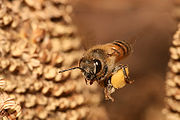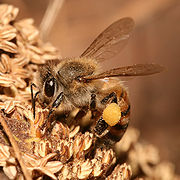
Pollen basket
Encyclopedia

Apidae
The Apidae are a large family of bees, comprising the common honey bees, stingless bees , carpenter bees, orchid bees, cuckoo bees, bumblebees, and various other less well-known groups...
bees that used to comprise the family Apidae
Apidae
The Apidae are a large family of bees, comprising the common honey bees, stingless bees , carpenter bees, orchid bees, cuckoo bees, bumblebees, and various other less well-known groups...
: the honey bee
Honey bee
Honey bees are a subset of bees in the genus Apis, primarily distinguished by the production and storage of honey and the construction of perennial, colonial nests out of wax. Honey bees are the only extant members of the tribe Apini, all in the genus Apis...
s, bumblebees, stingless bee
Stingless bee
Stingless bees, sometimes called stingless honey bees or simply meliponines, are a large group of bees, comprising the tribe Meliponini . They belong in the family Apidae, and are closely related to common honey bees, carpenter bees, orchid bees and bumblebees...
s, and orchid bees
Euglossini
Euglossine bees, also called orchid bees, are the only group of corbiculate bees whose non-parasitic members do not all possess eusocial behavior. Most of the species are solitary, though a few are communal, or exhibit simple forms of eusociality...
. The corbicula ("little basket") is a polished concavity surrounded by a fringe of hairs, into which the pollen is placed; most other bees possess a structure called the scopa
Scopa (biology)
The term scopa is used to refer to any of a number of different modifications on the body of a non-parasitic bee that form a pollen-carrying apparatus. In most bees, the scopa is simply a particularly dense mass of elongated, often branched, hairs on the hind leg...
, which is similar in function, but is a dense mass of branched hairs into which pollen is pressed, with pollen grains held in place in the narrow spaces between the hairs. A honey bee moistens the forelegs with a protruding tongue and brushes the pollen
Pollen
Pollen is a fine to coarse powder containing the microgametophytes of seed plants, which produce the male gametes . Pollen grains have a hard coat that protects the sperm cells during the process of their movement from the stamens to the pistil of flowering plants or from the male cone to the...
that has collected on head, body and forward appendages to the hind legs. The pollen is transferred to the pollen comb on the hind legs and then combed, pressed, compacted, and transferred to the corbicula on the outside surface of the tibia of the hind legs.
A single hair functions as a pin that secures the middle of the pollen load. Honey
Honey
Honey is a sweet food made by bees using nectar from flowers. The variety produced by honey bees is the one most commonly referred to and is the type of honey collected by beekeepers and consumed by humans...
and/or nectar is used to moisten the dry pollen. The mixing of the pollen with nectar or honey changes the color of the pollen. The color of the pollen can identify the pollen source
Pollen source
The term pollen source is often used in the context of beekeeping and refers to flowering plants as a source of pollen for bees or other insects. Bees collect pollen as a protein source to raise their brood. For the plant, the pollinizer, this can be an important mechanism for sexual reproduction,...
.

Pollen Collection
Apparently, Karl von FrischKarl von Frisch
Karl Ritter von Frisch was an Austrian ethologist who received the Nobel Prize in Physiology or Medicine in 1973, along with Nikolaas Tinbergen and Konrad Lorenz....
and other bee researchers have observed, individual honey bees vary in their efficiency in packing pollen into the pollen basket, some more efficient, others less; it takes an individual worker bee from three to eighteen minutes to complete a pollen load and return to the hive.

